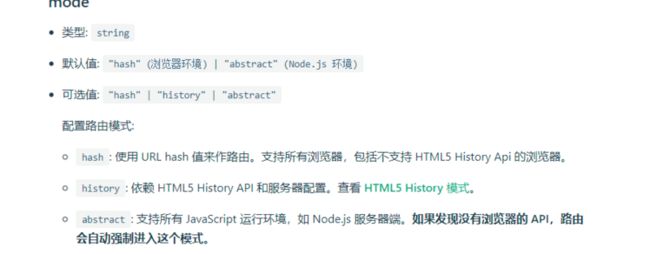在new vueRouter的时候我们可以传入一个mode属性,他可以接收三个值:hash/history/abstract
hash和history的区别
history的路径更美观一点 比如http://yoursite.com/user/id,history是基于pushState()来完成 URL 跳转而无须重新加载页面。 但是强制刷新还是会有问题(服务端来解决这个问题),所以history模式需要后端人员配合使用。
hash的路径会带有#,比如http://yoursite.com#/user/id
HashHistory
class VueRouter{
constructor(options){
this.matcher = createMatcher(options.routes || []);
//这里为了讲解hash模式 所以就不进行判断用户传进来的是哪种模式了
this.history = new HashHistory(this);//this vue-router的实例
}
}源码这里创建了一个基类我们这里和源码统一,这个基类封装了三种模式公用的方法和属性,那么我们在这里创建一个HashHistory和基类History
import History from './base'
// hash路由
export default class HashHistory extends History{
constructor(router){
super(router); //继承调用父类 等于call
}
}
// 路由的基类
export default class History {
constructor(router){
this.router = router;
}
}如果是hash路由,打开网站如果没有hash默认应该添加#/
import History from './base';
function ensureSlash(){
if(window.location.hash){
return
}
window.location.hash = '/'
}
export default class HashHistory extends History{
constructor(router){
super(router);
ensureSlash(); // 确保有hash
}
}再看一下初始化的逻辑(上面的router.init函数)
init(app){
const history = this.history;
// 初始化时,应该先拿到当前路径,进行匹配逻辑
// 让路由系统过度到某个路径
const setupHashListener = ()=> {
history.setupListener(); // 监听路径变化
}
history.transitionTo( // 父类提供方法负责跳转
history.getCurrentLocation(), // 子类获取对应的路径
// 跳转成功后注册路径监听,为视图更新做准备
setupHashListener
)
}这里我们要分别实现 transitionTo(基类方法)、 getCurrentLocation 、setupListener
getCurrentLocation实现
function getHash(){
return window.location.hash.slice(1);
}
export default class HashHistory extends History{
// ...
getCurrentLocation(){
return getHash();
}
}setupListener实现
export default class HashHistory extends History{
// ...
setupListener(){
window.addEventListener('hashchange', ()=> {
// 根据当前hash值 过度到对应路径
this.transitionTo(getHash());
})
}
}TransitionTo实现
export function createRoute(record, location) { // {path:'/',matched:[record,record]}
let res = [];
if (record) { // 如果有记录
while(record){
res.unshift(record); // 就将当前记录的父亲放到前面
record = record.parent
}
}
return {
...location,
matched: res
}
}
export default class History {
constructor(router) {
this.router = router;
// 根据记录和路径返回对象,稍后会用于router-view的匹配
this.current = createRoute(null, {
path: '/'
})
}
// 核心逻辑
transitionTo(location, onComplete) {
// 去匹配路径
let route = this.router.match(location);
// 相同路径不必过渡
if(
location === route.path &&
route.matched.length === this.current.matched.length){
return
}
//更新路由并且下面会提到改变根实例上的_route属性
this.updateRoute(route)
onComplete && onComplete();
}
}export default class VueRouter{
// ...
//做一个代理
match(location){
return this.matcher.match(location);
}
}macth方法
function match(location){ // 稍后根据路径找到对应的记录
let record = pathMap[location]
if (record) { // 根据记录创建对应的路由
//参数:/about/a:{path:xx,component...},path:'/about/a'
return createRoute(record,{
path:location
})
}
// 找不到则返回空匹配
return createRoute(null, {
path: location
})
}我们不难发现路径变化时都会更改current属性,我们可以把current属性变成响应式的,每次current变化刷新视图即可
在install方法中
install(Vue) {
Vue.mixin({ // 给所有组件的生命周期都增加beforeCreate方法
beforeCreate() {
if (this.$options.router) {
//调用Vue类中双向数据绑定方法
Vue.util.defineReactive(this,'_route',this._router.history.current);
}
}
});
// $route和$router方法 这两个方法仅仅是vue中最常见的代理 仅仅是为了更加方便
Object.defineProperty(Vue.prototype,'$route',{ // 每个实例都可以获取到$route属性
get(){
return this._routerRoot._route;//上面刚进行双向数据绑定的
}
});
Object.defineProperty(Vue.prototype,'$router',{ // 每个实例都可以获取router实例
get(){
return this._routerRoot._router;
}
})
}切换路由每次初始化时都需要调用更新_route的方法,因为install的时候把_route进行双向数据绑定,刚进来是没有this._router.history.current的,通过发布订阅方式来进行订阅和更新操作;在init方法中增加监听函数
history.listen((route) => { // 需要更新_route属性,出入一个函数
app._route = route
});export default class History {
constructor(router) {
// ...
this.cb = null;
}
listen(cb){
this.cb = cb; // 注册函数
}
updateRoute(route){
this.current =route;
this.cb && this.cb(route); // 更新current后 更新_route属性
}
}